Castericystis vali
Castericystis vali is a carpoid. This group of echinoderms is among the more unique types of
echinoderms becaue they have bilateral symmetry. Scientists think that the tail may have
been used for pushing the creature along. A few have proposed that they are related to the
first vertibrates, or may even have been our ancestors. Most believe it is just an early ancestor
of some classes of echinoderms. While most carpoids are symmetrical like these, there are a
small boot-shaped asymmetrical group of carpoids, though I've only seen a couple pictures of
such carpoids.
About the specimens
The two large carpoids are from the Middle Cambrian from the Marjum formation, Millard County, Utah.
The two juvenile carpoids are also from the Middle Cambrian from the Marjum formation, though
I have no info on their species or location. If anyone has a clue as to its species or genus,
let me know!


(left) Two carpoids. The top one appears to be rolled up with one antena sticking out.
you can see the impression of its tail to the right of it. The bottom one is stretched out
with one of its antennae on the left and its tail off to the right. The picture is slightly
larger than actual size (Scale=approx 1:1.6). (right) Baby carpoids! A group of some
partial juveniles that are either Castericystis vali or some similar carpoid. Actual size.
Suggestions?-email me.




